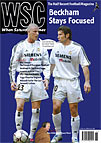 Keegan and Brut, McAteer and Head & Shoulders, Owen and Daz: Cameron Carter traces the evolution of player endorsements
Keegan and Brut, McAteer and Head & Shoulders, Owen and Daz: Cameron Carter traces the evolution of player endorsements
Before the current era of personal branding, footballers were placed in front of the camera merely as celebrated tradesmen whose fame, as a result of mastery of their craft, was viewed as sufficient reason for the impressionable viewer to go out and buy the very latest hair lacquer.
No one looking upon the photographs of Dixie Dean sucking moodily upon a Carreras Club cigarette (“the cigarette with a kick in them”) would have expected to gain an insight into the Dean personality. He looked a bit like he’d just given his wife one last chance to stop talking but he might just as well have been under the hypnotic spell of the insinuating weed (five for tuppence). Dean wasn’t being cute, or funny, or rebranding himself; he was simply being that fellow who scores loads of goals for Everton. Stanley Matthews’ image was used as an oblique reference in another early advertising campaign, suggesting the quality of smoothness shared between Craven A cigarettes and Matthews’ ball control. All you could possibly glean from this promotion was Matthews’ profession – there could not even be a direct link between player and product as Stanley was a devout non-smoker. Similarly, Denis Compton’s famous Brylcreem advertisement intimated only that Denis knew how to keep his hair simple for the big game, not that he was a mover in squeaky dance halls and certainly not that he used the product because he was worth it. Perhaps Sixties star George Cohen gave away a little more when stating that Elliman’s Athletic Rub was “both vital and stimulating for my legs” but, for the most part, good, sturdy endorsement was all that was necessary in this golden age.
Little had changed by the 1970s when Pat Jennings flung himself around a muddy goalmouth demonstrating the goalkeeper’s generic similarity to an oil filter while a highly stimulated crowd chanted “Unipart” until the word became almost meaningless. Pat was definitely not being iconic here. He was being a goalkeeper, like it said in the script. George Best appeared on Ulster TV in his “El Beatle” period with a Cookstown sausage on his fork and a sultry come-to-pub look in his eyes. Clearly, a link between the player’s perceived image and the product he recommended was not yet thought vital.
Kevin Keegan started the acting malarkey when he emerged from the steam of a highly charged dressing room to be matey with Henry Cooper about their shared aftershave. Apart from dully wondering how these two coincided at the communal showers unless they arranged to meet there, the viewer was led to believe for the first time that life went on for the professional footballer after he left the pitch. Perhaps he talked rather like a robot recovering from a stroke, but Keegan appeared to have a civilian existence and something approaching a personality to go with it.
John Barnes took us backstage again in a Lucozade Sport commercial, in which we saw our hero solitary, drained and spent “after 90 minutes of sheer hell”. One had always assumed that Barnes enjoyed play-ing football to some extent but, no, every game was infernal to him. This was an insight into the man and would explain why, a decade and a half later, he looks like he would rather be absolutely anywhere else when he hosts matches on Five.
Joe Jordan’s toothless Heineken advert we can dismiss as diverting slapstick but, as television’s relationship with football became mature and serious, image-building entered the equation. With the exception of Jason McAteer’s anti-dandruff shampoo commercial (despite lathering himself heavily, Jason aroused little erotic reaction unless you count sexual swear words), the modern football advertisement picks out the selling strength in each player. David Ginola was scented and flowing in his L’Oreal ad (not, however, doing much to dispel the idea that Frenchmen are essentially women with mistresses). Reebok, giving us Peter Schmeichel in his parallel universe career as a Danish pig farmer, sold us the scream-faced fanatic as a humble, honest labourer. Alan Shearer, signing autographs ceaselessly in a McDonald’s ad, is a solid man of the people. Michael Owen, turning out for Daz Automatic, loves his mother (Walkers crisps dropped Owen from their recent campaign because his image was too clean-living for the target audience of pub-goers). David Beckham, through mostly keeping his mouth shut on screen, has developed the presence of a simpleton minor deity, which makes life easy for him and the copywriters.
And now we’re stuck for the foreseeable future with big Nike/Pepsi productions with casts of thousands, which may soon become pay-per-view. They’re skilfully done and even old Ronaldinho looks like he could get away with a short film career, but the contemporary player is now noticeably pulling out of tackles and heading the ball less so as not to jeopardise his midweek close-up. Playing football is not enough for them these days. I ask you to find absolutely any picture of Dixie Dean and imagine what he would have thought of this.
From WSC 208 June 2004. What was happening this month